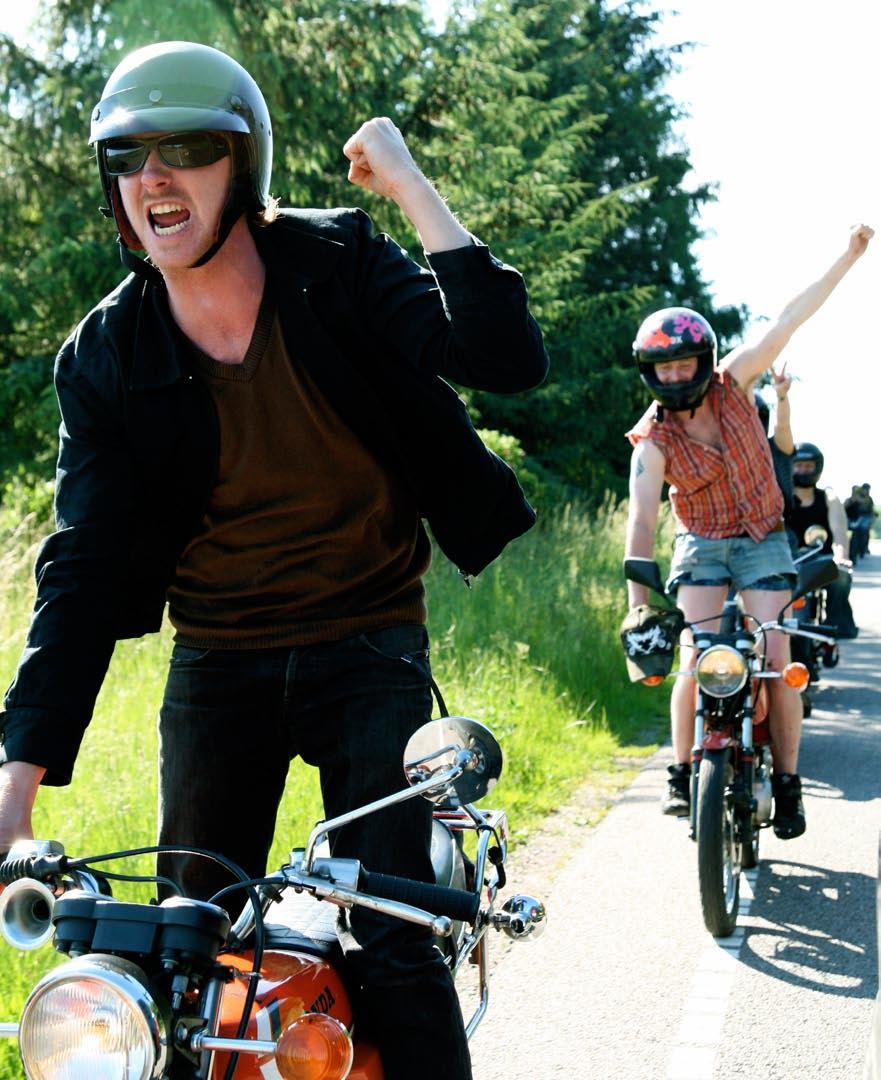"The Wild Hearts" is a documentary road movie about 12 young Danish guys who, as a combined oath of brotherhood, rite of passage and madcap adventure, ride their mopeds 1,300 kilometres from Odense in Denmark to Pomerania in Poland.
"These guys had this insane drive and it seemed obvious to try and harness it ... to make a film where I'd get to pull some more fictional levers."
Known as The Wild Hearts (De Vilde Hjerter), the gang and its interactions are heavily about bonding through transgression. Meanwhile, as the kitschy nickname implies, a good-sized helping of irony is involved. The members are all in their early or mid-twenties and the whole idea of moped-riding is evidently inspired by their parents’ generation that rode mopeds in the 1970s. The gang’s universe is riddled with mythology, symbols and ritual, balancing – typically, perhaps, for their generation – between hi-jinx and sincerity, detachment and passion. All the while, gravity lurks just behind the goofball facade.
FREEDOM AND BROTHERHOOD
Though several members of The Wild Hearts are apparently in long-term relationships, they put a big premium on spending time with their buddies. Throughout the film, the young men behave like hybrids of latter-day Vikings and sensitive, metrosexual young guys on wild-man weekends. They are not afraid to show their feelings for each other, directly and unambiguously declaring their love for each other. They share everything, even the most intimate things. They kiss and hug, they are naked around each other, they drink themselves senseless and chase ecstasy together. In an ultimate expression of their common bond, they subject themselves to ritual branding with a heart-shaped iron. All in celebration of what it’s all about for them: freedom and brotherhood.
Michael Noer and his cameraman tagged along for the whole ride. We are spared not a single bodily function, as the film unsparingly documents every aspect of the moped boys’ time together, from the most ecstatic highs to the darkest pits of despair and doubt, homesickness, cluelessness and conflict. Even so, the camera politely stays outside closed doors when the guys – in typical bonehead fashion – make a stop at a porno centre on the Danish-German border, giddily pick out a movie each and vanish into separate stalls conveniently equipped with paper towels.
In light thereof, it seems reasonable to ask the director where he personally draws the line:
“I already did one film where we followed someone into one of those stalls,” Noer told me. “So it’s not that we didn’t dare show what goes on in there. But one of the more heated arguments that I had with my editor, Adam Nielsen, when we made the film, was about how we didn’t want people to think these guys are gay. Not that there’s anything wrong with being gay, obviously, only it’s not about that.”
“Generally, though, I don’t think there’s anything you shouldn’t film or show, as long as it extends the story,” the filmmaker says. “I always make the same deal with people who appear in my films. They give me permission to film anything I want while it’s going on, and they for their part always have an unqualified right to have a scene edited out later. Luckily, to date no one has ever asked me to cut anything, at least nothing important.”
BETWEEN WILDNESS AND INTIMACY
Noer (b. 1978) is a 2003 graduate of the National Film School of Denmark’s TV programme. His graduation film, "En rem af huden", was a portrait of Ole Ege, a pioneer in Danish pornography in the ‘50s, ‘60s and ‘70s and currently the manager of Copenhagen’s Museum Erotica. Though formally less transgressive than its subject, the film did demonstrate a sure craftsman’s touch and a fearlessness about facing reality in all its aspects.
Three years later, Noer had a minor breakthrough with "The Earth Beneath My Feet" (2006), a classic one-man-one-camera production about Dan and David, two maladjusted teenage boys staying at Slettebjerggaard, a home for kids whose families are in crisis. The film showed Noer to be an empathic and patient filmmaker with a distinct talent for combining unfeigned interest and loyalty regarding his characters with a highly developed sense of intimacy and nuances in individual scenes.
All the same, Noer surprised everybody in autumn 2007 when he had his big breakthrough with "Vesterbro", a documentary about a young couple and their frenzied daily life in one of Copenhagen’s most colourful neighbourhoods. While before, he had cloaked his talent in anonymity, he now let it all hang out with explosive force in a film that pulls in even closer on real life than we are used to in a documentary, even as he employed a number of feature-film moves obviously geared to the big screen. From start to finish, "Vesterbro" runs full throttle on all expressive parameters, while also proving that a documentary filmmaker doesn’t have to travel halfway around the world to locate a reality he can transform into exotic and engaging storytelling. If "The Earth Beneath My Feet" sometimes gave the impression of straining the filmmaker’s expressive ambitions to the maximum, Noer now seemed to have found a form that let him achieve far more without jeopardising his story’s natural lightness.
"Vesterbro’s" two protagonists are Noer’s neighbours in real life. In a choice move, strengthening the film’s sense of authenticity and intimacy, the filmmaker left a camera with his subjects and encouraged them to film their day-today life, including when he and his crew weren’t around. The result is a film that combines a classic documentary approach with the intimate medium of the video journal familiar mainly from video art and more experimental documentaries.
Noer further explored the method of having his subjects operate the camera in "Doxwise" (see page 30). For this Internet project, he gave camcorders to four young people and asked them to keep a video journal for 10 weeks according to a set of simple guidelines. The tapes were later edited into four times ten episodes, which were then posted on YouTube.
"The Wild Hearts". Photo: Thomas Gerhardt
ARCHETYPES
"The Wild Hearts", Noer’s next project after "Vesterbro" and "Doxwise", was shot on a trip to Pomerania in Poland that lasted almost four weeks and eventually became exceedingly strenuous for everyone involved, including the crew. In fact, the prospect of doing a documentary genre film, a road doc, was one of the things that turned Noer on to the project:
“To find inspiration for the film, I looked through my DVD collection and realised that road movies made for TV always use the same classic concept where they dispatch Biker Jens (a Danish television personality –ed.) or someone like him to Texas to munch on giant burgers and that sort of thing, while very few real documentaries have been made in that genre. These guys had this insane drive and it seemed obvious to try and harness it, now that it fit the genre so well. I figured I could use that to make a film where I’d get to pull some more fictional levers,” Noer says.
A major challenge in that respect was how to deal with having 12 main characters:
“One of the first things I did was to get everyone to write a description of themselves,” Noer says. “That turned out to be a really good idea, and I’ll definitely use it again sometime, because it made them feel that they had invested something in the film project. As in a classic multi-plot story with an ensemble cast, I devised archetypes for them based on what they had written. That allowed us to distil out certain characteristics for me to use later when I sat down and tried to envision the whole film, writing it out from start to finish with scenes and everything. In that respect, the preproduction was a lot like making a fiction film. But of course it’s a documentary, so it didn’t go like the manuscript said.”
Finally, people at the documentary film meeting in Ebeltoft wanted to know if Noer had prodded the action, how much he had tried to influence his cast of characters to do certain things for the sake of the film.
“An interesting thing about this film is that the T"he Wild Hearts", because they were always going for the extreme, were into staging things themselves,” Noer says. Accordingly, we only had to nudge them a little bit in certain directions they were already going. As is often the case in all groups, everyone had taken on or been assigned a certain role or character, and we only had to tighten that up a little bit to make them stand out as archetypes in the film. In that sense, our project is always an extension of theirs.”


